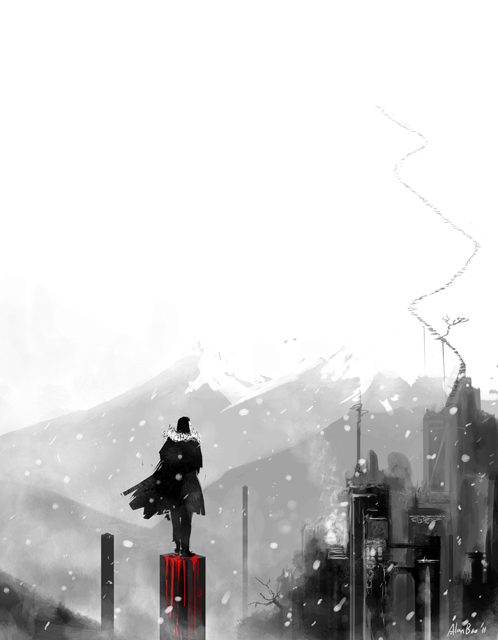
art by Alan Bao
Are You There? Are You Safe? Is the Flock Safe?
by D. Robert Hamm
Even this close to the desert, the sun finds enough cloud on which to paint its retirement colors. Turner Bray sits beside an almost-dry stream under a Joshua tree while the oranges and yellows and reds and pinks fade into one another, and listens to the birds.
They are not Original birds, of course; the stores of avian DNA were among the many things damaged on the voyage here, centuries ago. They might look like Original birds, and hatch from eggs like Original birds, but they are partly carbon filament and nanotubes, and they grow tiny processors in their brains to guide them--with varying degrees of success--toward Original bird behavior.
This flock--Turner's flock--comprises both parakeets and cockatiels, as well as a mated pair of African Grays and an elderly Amazonian Parrot. Original Birds did not mix like this in the wild, and that is part of why Turner is here; to learn more about how these birds differ in behavior from Originals so that new designs can take into account the failures of the past.
As the light fades, the birds start up the evening chatter that binds them as a flock in much the same way it must have for Original birds. They speak in chirrups and sweels and little squawks that ask, "Are you there? Are you safe? Is The Flock safe?" And they answer each other, "I am here. I am safe. The Flock is safe."
To pass the days and weeks, Turner teaches himself to imitate the bird calls, becoming fluent enough to engage in their daily reassurances. Sometimes he spreads crumbled rations on the ground and calls out in their language, "Food! Food! There is food here!" After a while, most will eat tidbits directly from his hand, and after a longer while they seem to accept as one of them this wingless giant who speaks the language of the flock.
The birds have names for each other. They give Turner a name, as well--a simple, trailing squawk--and even contact-call to him when he moves out of sight. "Where are you? We can't see you! Are you safe?"
On the day of the snake attack, Turner is recording. Although he should simply observe, his first reaction is to raise the alarm. "Snake! Snake! Protect the chicks!" The snake is menacing the Grays' nest, but it is a little cockatiel--his real name is a lilting whistle, but Turner has dubbed him Geronimo for his bravery--who throws himself at the snake's eyes, protecting the chicks for the scant second it takes the rest of the flock to descend in a fury of beaks and claws and battering wings.




